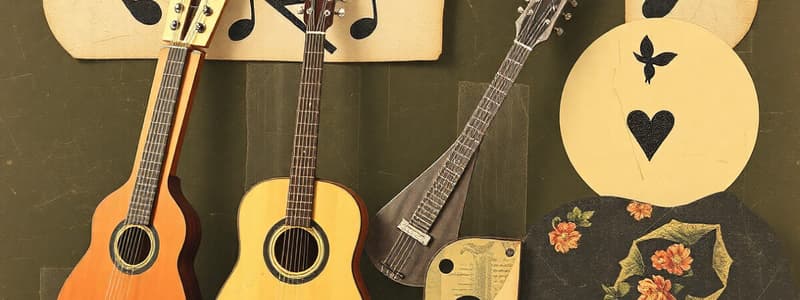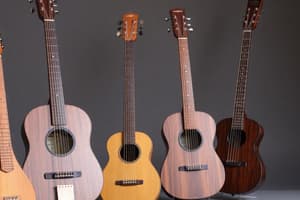Podcast
Questions and Answers
What is the primary function of a resonator in a chordophone?
What is the primary function of a resonator in a chordophone?
- To create the initial vibration of the strings.
- To hold the strings in place.
- To determine the pitch of the instrument.
- To amplify the sound produced by the vibrating strings. (correct)
Which of the following chordophones has its strings raised on a bar above the resonator?
Which of the following chordophones has its strings raised on a bar above the resonator?
- Lyre (correct)
- Zither
- Lute
- Harp
How is sound produced in a chordophone?
How is sound produced in a chordophone?
- By striking a membrane
- By blowing air through a reed
- By vibrating strings (correct)
- By resonating a hollow body
The Yangqin, a hammered dulcimer, originated in which region?
The Yangqin, a hammered dulcimer, originated in which region?
What distinguishes a lute from other chordophones?
What distinguishes a lute from other chordophones?
Which instrument experienced a decline in popularity in the early 19th century but has regained recognition in modern times?
Which instrument experienced a decline in popularity in the early 19th century but has regained recognition in modern times?
Which instrument is characterized by a triangular body and three strings?
Which instrument is characterized by a triangular body and three strings?
What material are the Yangqin's beaters traditionally made of?
What material are the Yangqin's beaters traditionally made of?
Which of the following is NOT a way strings can be played on a chordophone?
Which of the following is NOT a way strings can be played on a chordophone?
Flashcards
Chordophones
Chordophones
Instruments that produce sound by vibrating strings.
Resonator
Resonator
The hollow part of a chordophone that amplifies sound.
Lutes
Lutes
Chordophones with strings over a resonator and neck, e.g., guitars.
Zithers
Zithers
Signup and view all the flashcards
Harps
Harps
Signup and view all the flashcards
Lyres
Lyres
Signup and view all the flashcards
Musical Bows
Musical Bows
Signup and view all the flashcards
Yangqin
Yangqin
Signup and view all the flashcards
Balalaika
Balalaika
Signup and view all the flashcards
Study Notes
Chordophones
- Chordophones are stringed instruments, known since ancient times, in various shapes and sizes.
- They produce sound through vibrating strings that are played with bows, plucked with fingers, or struck with hammers.
- Nearly all chordophones use strings stretched across a resonator (hollow part), amplifying the sound.
Five Basic Types of Chordophones
- Lutes: Strings stretched over a resonator, extending along the neck (e.g., guitars, violins).
- Zithers: Strings stretched across or inside a resonator, or between two resonators.
- Harps: Strings placed slanted within a frame.
- Lyres: Strings are attached to a bar above the resonator.
- Musical Bows: Strings stretched from one end of a bow to the other.
Yangqin
- A trapezium-shaped Chinese instrument, similar to a hammered dulcimer originally from Persia.
- Played by striking the strings with bamboo beaters.
Balalaika
- A Russian folk instrument with a triangular body and three strings.
- Comes in various sizes (6 or more) ranging from low to high pitches.
Medieval Lute
- A popular instrument in 14th-century Europe.
- Used in Renaissance and Baroque music, but later lost popularity.
- Experienced a revival of interest in modern times.
Studying That Suits You
Use AI to generate personalized quizzes and flashcards to suit your learning preferences.




